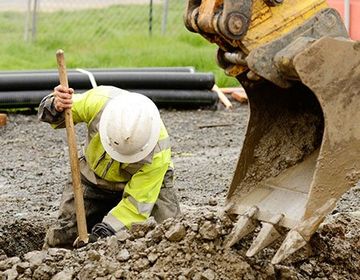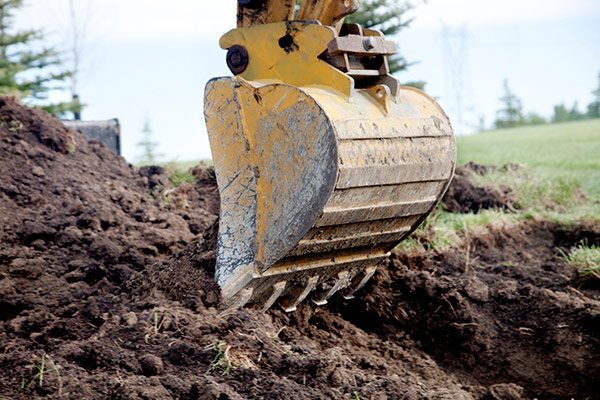Dump Truck Companies in Ohio - Reliable Dump Truck Services Across Ohio
Dump Truck Companies in Ohio - Reliable Dump Truck Services Across Ohio
Blog Article
Revealing the Art of Excavation: Pro Tips for Safe and Efficient Digging
In the realm of excavation, the proficiency of safe and productive digging is an art form that calls for expertise, adherence, and precision to well-known methods. As soil is transformed and earth is relocated, the details of excavation expose themselves, requiring a keen understanding of equipment, dirt composition, safety and security procedures, and environmental factors to consider. The experience required to navigate these aspects successfully can imply the distinction between an effective excavation job and a possible catastrophe. By untangling the layers of this complex process, a world of strategies and insights waits for those seeking to boost their excavation skills to new elevations.
Relevance of Proper Devices
To make certain the safety and effectiveness of any type of excavation task, utilizing the suitable devices is extremely important. The right tools not only improve efficiency yet additionally mitigate risks connected with excavating. Excavation tasks differ in extent and complexity, ranging from small domestic landscaping tasks to massive building and construction tasks. No matter of the project size, having the correct equipment can make a considerable difference in the result.
Excavators are essential pieces of machinery in any digging operation. These versatile makers come in various sizes to fit different project requirements. Mini excavators are optimal for smaller tasks, while larger excavators tackle much more comprehensive jobs effectively. Backhoes are one more vital devices type, integrating the features of a loader and an excavator in one equipment. They are beneficial for jobs needing versatility and maneuverability.
Aside from excavators, other vital tools consists of dump excavators, trenchers, and vehicles. Dump trucks are essential for eliminating and transporting excavated materials, while plates are used for digging deep and narrow trenches. Bulldozers succeed in tasks that need pressing large quantities of dirt or particles. By purchasing the proper tools, excavation projects can be completed securely, on time, and with precision.
Recognizing Soil Structure
An extensive understanding of dirt structure is essential for implementing excavation tasks with precision and security. Comprehending the various sorts of dirt is important as it straight influences excavation approaches, equipment selection, and general task performance. Soil structure typically includes four primary components: sand, silt, clay, and raw material. Each element has special homes that influence exactly how soil reacts to excavation processes.
Silt fragments are smaller sized than sand but bigger than clay, using moderate water drainage and cohesion. Organic matter, such as decomposing plant material, influences soil fertility and security.
Before commencing excavation, performing soil examinations to identify its make-up and attributes is vital. This information assists in selecting the ideal devices, applying security measures, and creating excavation techniques customized to the particular dirt conditions - excavating ohio. By recognizing soil structure, excavation professionals can improve task outcomes while making certain safety and adherence to finest practices
Precaution and Protocols
Comprehending dirt composition is the foundation whereupon precaution and methods for excavation projects are developed, making certain the well-being of workers and the success of the venture. There are numerous vital procedures that must be applied to reduce threats and protect against crashes. when it comes to security throughout excavation.
First and leading, prior to any digging commences, a complete examination of the website should be conducted to identify any potential hazards such as underground utilities, unstable dirt problems, or neighboring frameworks that can posture a threat. It is vital to have an experienced individual look after the excavation procedure to make sure that all security procedures are complied with strictly.
In addition, all employees included in the excavation should be properly trained in secure excavating practices and the proper procedure of devices. By adhering to these safety actions and procedures, excavation jobs can be completed successfully and without occurrence.
Effective Excavation Preparation
When starting an excavation job, precise preparation is necessary to make certain efficiency, safety, and successful end results. Efficient excavation preparation entails several vital steps that are essential for the smooth implementation of the job. The primary step is to conduct a thorough website assessment to recognize any possible risks, such as below ground utilities or unpredictable soil problems. This information is crucial for developing a thorough excavation plan that consists of precaution and risk mitigation approaches.
Once the site evaluation is full, the next step is to produce a clear timeline and timetable for the excavation tasks. This includes identifying the series of jobs, equipment requirements, and manpower allowance. Correct scheduling helps prevent hold-ups and makes certain that the task remains on track.

Furthermore, communication among all team members is critical during the planning phase. Clear instructions, normal updates, and reliable control are crucial for an effective excavation task. By spending time and effort in precise planning, excavation groups can significantly boost performance, lessen dangers, and accomplish successful end results.

Managing Ecological Considerations
With increasing focus on environmental sustainability in building practices, handling environmental factors to consider has actually ended up being a vital facet of excavation projects. Excavation tasks have the potential to impact the surrounding environment via soil erosion, sediment overflow, environment disruption, and contamination of water sources. To alleviate these risks, it is important to execute ideal practices that prioritize environmental management.

In addition, correct waste administration is important to stop soil and water contamination. Executing procedures for the disposal of hazardous products, recycling of waste products, and reducing making use of harmful chemicals can significantly lower the ecological effect of excavation projects. By incorporating these methods into excavation planning and implementation, building companies can make certain that their jobs are not only secure and efficient but additionally ecologically responsible.
Verdict
Finally, mastering the art of excavation calls for a complete understanding of appropriate tools, dirt composition, precaution, and effective preparation. By following these standards and considering ecological elements, excavations can be performed safely and successfully. It is vital to prioritize security and productivity in every excavating task to make sure effective results.
As dirt is turned and earth is relocated, the complexities of excavation disclose themselves, demanding an eager understanding of tools, soil make-up, safety procedures, and ecological considerations.To make sure the safety and effectiveness of any kind of excavation project, using the ideal equipment is vital.A comprehensive understanding of dirt make-up is fundamental for implementing excavation jobs with accuracy and safety and security. Comprehending the different types of dirt is crucial as it directly affects excavation techniques, tools option, and overall job effectiveness. By recognizing dirt composition, excavation professionals can improve job results while making certain safety and adherence to best practices.
Report this page